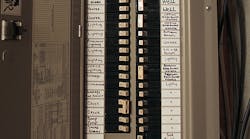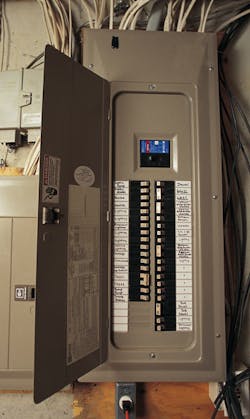Low-voltage circuit breakers must be installed so that they are trip free and capable of being closed and opened by manual operation of the hands. As noted, this means that normal operation by other than manual means, such as electrical or pneumatic, is permitted if means for manual operation is also provided. Circuit breakers must clearly indicate that they are either in the open (“OFF “) or closed (“ON”) position. When working with circuit breaker handles that are operated vertically and not rotationally or horizontally, the “up” position of the handle indicates the “ON” position and the down position indicates the “OFF” position.
Circuit breakers must be marked with an ampere rating by the manufacturer in a manner that’s durable and visible after installation. However, markings are permitted to be covered by a panel trim or cover. Circuit breakers rated at 100A or less and 1,000V or less are required to have their ampere rating molded, stamped, etched, etc., into their handles. Circuit breakers having an interrupting rating other than 5,000A must have their interrupting rating displayed on the circuit breaker. This interrupting rating is not required to be marked on circuit breakers used for supplementary protection of equipment.
Circuit breakers can be used as switches in 120V and 277V fluorescent lighting circuits where they are listed and marked “SWD” or “HID.” Circuit breakers must be marked with a voltage rating not less than the nominal system voltage. This rating indicates the circuit breaker’s capability to interrupt fault currents between phases or from phase-to-ground. It’s important to remember that circuit breakers with a straight voltage rating, such as 240V or 480V, can be installed in a circuit in which the nominal voltage between any two conductors does not exceed the circuit breaker’s voltage rating. A 2-pole circuit breaker must not be used for protecting a 3-phase, corner-grounded delta circuit unless it is marked “1Ø–3Ø” to indicate it is for such use. A circuit breaker with a slash rating, such as 120/240V or 480Y/277V can be installed in a solidly grounded circuit where the nominal voltage of any conductor to ground does not exceed the lower of the two values of the circuit breaker’s voltage rating and the nominal voltage between any two conductors does not exceed the higher value of the circuit breaker’s voltage rating.
Inspection and cleaning
As noted in Sec. 17.8 of NFPA 70B, Recommended Practice for Electrical Equipment Maintenance, insulated-case and molded-case circuit breakers should be kept clean of external contamination so that internal heat can be dissipated in a normal manner. A clean case also reduces a possible arcing condition between exposed live conductors and between energized conductors and ground. In addition, the case should be inspected for cracks and replaced where necessary. The structural strength of the case is important in withstanding the stresses generated during fault-current conditions.
Loose connections
As noted in Sec. 17.9 of NFPA 70B, excessive heat in a circuit breaker can cause nuisance tripping and possibly lead to a failure. Loose connections are the most common cause of excessive heat. Maintenance inspections for loose connections or evidence of overheating should be checked as necessary. Tightness of loose connections should be performed and comply with Sec. 8.11. Insulated-case and molded case circuit breakers having non-interchangeable trip units are appropriately adjusted, tightened, and sealed at the factory. Interchangeable trip units installed and maintained improperly may overheat if not tightened properly during installation. Manufacturer’s recommended maintenance procedures of connections should be followed.
Mechanical mechanism exercise
As noted earlier, circuit breakers with moving parts require periodic inspection for loose connections and overheating problems. Sec. 17.10 of NFPA 70B also notes that manual operation of the circuit breaker will help keep the contacts clean and aid in the lubrication performance. Although manual operation exercises the breaker mechanism, none of the mechanical linkages in the tripping mechanisms are moved with this exercise. Some circuit breakers feature push-to-trip buttons that should be manually operated to exercise the tripping mechanism linkages in a proper manner. Note: Annex K covers long-term maintenance procedures and Annex L deals with maintenance intervals. Where testing is necessary, see NETA guidelines and specifications for such procedures.
Conclusion
Maintenance personnel must remember that insulated-case and molded-case circuit breakers will trip from exposure to continuous currents that are greater than their amperage ratings. Circuit breakers can also trip from unduly high ambient temperatures and improper connection. Maintenance personnel must understand that insulated-case and molded-case circuit breakers installed in a panelboard should not be loaded in excess of 80% of its continuous current rating (125% times the load). Continuous load is defined in Art. 100 of the National Electrical Code (NEC) as operating for three or more hours.
Circuit Breaker Construction
An insulated-case and molded-case circuit breaker consist of two general parts. The first part of the device consists of the current-carrying conductors, contacts, and operating mechanism necessary to perform the circuit-switching function. The second part of the device comprises the protective element, including the tripping mechanism associated with the circuit breaker. Note: Insulated-case and molded-case circuit breakers, including enclosures carrying a UL label, are factory-sealed units.
James G. Stallcup is CEO of Grayboy, Inc. in North Richland Hills, Texas. James W. Stallcup is VP and senior editor of Grayboy, Inc. They can be reached at [email protected].




